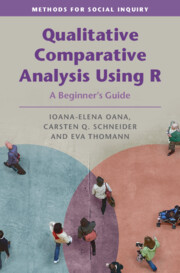5 - Rounding Up a Solid QCA
Published online by Cambridge University Press: 07 October 2021
Summary
A solid QCA does not end with the analytic moment. Researchers must make several analytic decisions at various stages in the analysis, some with more confidence than others. Researchers might also be confronted with data that are structured in analytically relevant ways. For example, cases might group into different geographic, substantive, or temporal clusters, or there might be relevant causal dependencies or sequences among conditions.
This chapter introduces the different robustness and diagnostic tools available in R to assess QCA results. It enables the reader to investigate to what extent their QCA results are robust against equally plausible analytic decisions regarding the selection of calibration anchors or consistency and frequency cut-offs. We present possibilities to assess robustness in R. Moreover, we introduce tools for cluster diagnostics and discuss strategies for dealing with timing and temporality, including ‘coincidence analysis’ (CNA).
Learning goals:
- Basic understanding of different approaches to diagnosing and assessing QCA results.
- Familiarity with how the robustness of QCA results to different analytical decisions can be assessed.
- Familiarity with proposals on how to assess QCA results in the presence of clustered data.
- Familiarity with how to model sequences and causal chains in R.
Keywords
- Type
- Chapter
- Information
- Qualitative Comparative Analysis Using RA Beginner's Guide, pp. 143 - 171Publisher: Cambridge University PressPrint publication year: 2021

